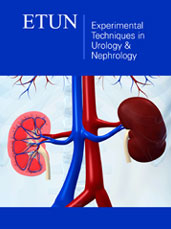- Submissions

Abstract
Experimental Techniques in Urology & Nephrology
Uroflowmetry and Post-Void Urine Volume in the Initial Evaluation of Suspected Obstructive Prostatic Enlargement
-
Open or Close Sigiberto II García-Nares1* and Álvaro José Montiel-Jarquín2
1Department of Urology, El Marqués Regional General Hospital, Mexico
2Department of Investigation, Traumatology and Orthopedics Hospital (UMAE), Mexico
*Corresponding author: Sigiberto II Garcia Nares, Department of Urology, “El Marqués” Regional General Hospital, Mexican Social Service Institute IMSS, Queretaro, Mexico
Submission: September 02, 2017; Published: November 14, 2017

ISSN: 2578-0395 Volume1 Issue2
Abstract
The obstructive prostatic enlargement is the most common benign pathology in men. For its evaluation, it is used the digital rectal exam, questionnaires of the lower urinary tract symptoms, prostate specific antigen and complimentary tools like pelvic and transrectal ultrasound, uroflowmetry, urethrocystogram and urethrocystoscopy. In Mexico, the uroflowmetry is not commonly used for diagnosing obstructive prostatic enlargement.
Objective: To determine the usefulness of the uroflowmetry and residual urine volume in the evaluation of men with suspected obstructive prostatic enlargement in the first visit to the urologist.
Material and methods: Descriptive and cross sectional study in men older than 40 years, who were asked about lower urinary tract symptoms, uroflowmetry and measurement of residual urine volume.
Results: 95 patients with suspected obstructive prostatic enlargement. 25 (26.3%) patients had non obstructive pattern and 70 (73.7%) obstructive pattern. In the results of uroflowmetry and ultrasound (combined), 26 (27.4%) patients were non obstructive and 69 (72.6%) obstructive. The concordance between the uroflowmetry and the final result was 0.812 (Kappa). The correlation between the percentage of residual volume and the final result was 0.644, p=0.0001 (ρ of Pearson) and the correlation between prostate weight and final result was 0.4830, p=0.0001 (ρ of Pearson).
Conclusion: The uroflowmetry with the International Index of Prostatic Symptoms guide to the severity of prostatic symptoms and with the residual urine volume can help to begin prompt treatment for obstructive prostatic enlargement.
Keywords: Uroflowmetry; Post-void residual urine; Obstructive prostatic enlargement.
 a Creative Commons Attribution 4.0 International License. Based on a work at www.crimsonpublishers.com.
Best viewed in
a Creative Commons Attribution 4.0 International License. Based on a work at www.crimsonpublishers.com.
Best viewed in 







.jpg)






























 Editorial Board Registrations
Editorial Board Registrations Submit your Article
Submit your Article Refer a Friend
Refer a Friend Advertise With Us
Advertise With Us
.jpg)






.jpg)














.bmp)
.jpg)
.png)
.jpg)










.jpg)






.png)

.png)



.png)






